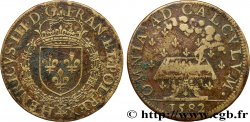Live auction - bry_809187 - LOUIS XIV "THE SUN KING" Essai de la pièce de cinq liards (pièce de 15 deniers tournois) 1657 Bordeaux
You must signin and be an approved bidder to bid, LOGIN TO BID. Accounts are subject to approval and the approval process takes place within 48 hours. Do not wait until the day a sale closes to register. Clicking on "BID" constitutes acceptance of the terms of use of cgb.fr private live auctions.
Bids must be placed in whole Euro amounts only. The sale will start closing at the time stated on the item description; any bids received at the site after the closing time will not be executed. Transmission times may vary and bids could be rejected if you wait until the last second. For further information check the Live auction FAQ
All winning bids are subject to a 18% buyer’s fee.
All winning bids are subject to a 18% buyer’s fee.
| Estimate : | 15 000 € |
| Price : | no bid |
| Maximum bid : | no bid |
| End of the sale : | 07 March 2023 16:10:07 |
Type : Essai de la pièce de cinq liards (pièce de 15 deniers tournois)
Date: 1657
Mint name / Town : Bordeaux
Metal : silver
Diameter : 25 mm
Orientation dies : 6 h.
Edge : lisse
Rarity : R3
Slab

NGC : 55
Coments on the condition:
Cet essai est frappé sur un flan large et régulier. Exemplaire recouvert d’une patine grise présentant des taches au droit. Petite paille de métal sous le K du revers et petits coups
Predigree :
Exemplaire sous coque NGC, AU55, n° 5785797-023
Obverse
Obverse legend : LVD. XIIII. D G. FR. ET. NAVAR. REX..
Obverse description : Buste enfantin de Louis XIV à droite, lauré, drapé et cuirassé à l'antique, portant l'ordre du Saint-Esprit, une longue mèche descendant sur la cuirasse.
Obverse translation : (Louis XIV, par la grâce de Dieu, roi de France et de Navarre).
Reverse
Reverse legend : CINQ LIARTS.
Reverse description : sous un trait d’exergue ; au-dessous trois lis posés 2 et 1 sous une couronne, un K sous la couronne, le lis inférieur accosté de 16-57 ; point au-dessus du 1 du millésime.
Commentary
Essai de la plus grande rareté. Sur le seul fait que la pièce de 30 deniers de cette série conservée du cabinet des médailles de la BnF présente des traces d’usure, Jean Duplessy a classé ces essais parmi les monnaies courantes et parfois sous l’appellation farfelue de double sols parisis et sol parisis, alors que Frédéric Droulers le considère comme un essai. Nous donnons raison à Frédéric Droulers, car aucune pièce de six blancs ou de cinq liards n’est présente dans les boîtes de la Monnaie de Bordeaux, prouvant que cette pièce ne fut pas mise en circulation. De plus, ce type monétaire correspond à un essai de la pièce de 15 deniers prévue lors du bail avorté qui avait été accordé en 1657 à Pierre Tissier par le Conseil du roi.








 Report a mistake
Report a mistake Print the page
Print the page Share my selection
Share my selection Ask a question
Ask a question Consign / sell
Consign / sell
 Full data
Full data















